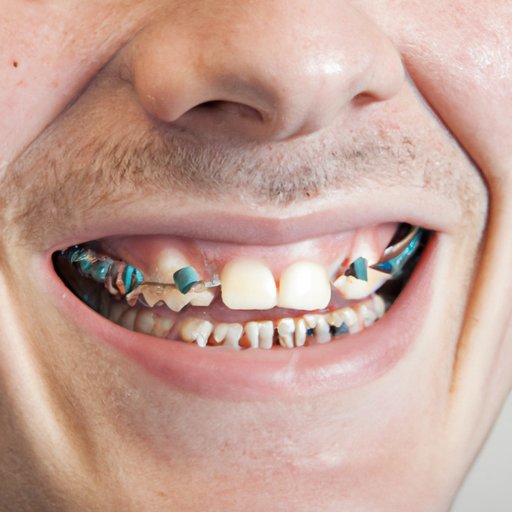I. Introduction
If you or someone you know is getting braces or currently has them, you may have heard stories about the discomfort and pain that can come with them. It’s no secret that braces can be uncomfortable, but why exactly do they hurt? In this article, we will explore the science behind the pain caused by moving teeth with braces, share personal experiences of those with braces, examine how braces have improved over the years, offer tips for pain relief, address common misconceptions, and discuss the psychological impact of braces on patients and ways to mitigate it.
II. Understanding the Science Behind the Pain Caused by Moving Teeth with Braces
Braces work by applying pressure to the teeth to shift them into their desired position. The archwire, which connects each bracket, places pressure on the teeth, causing them to move. As the teeth move, the surrounding gums and bone tissue must also adjust.
During the biological process of tooth movement, special cells called osteoclasts break down bone tissue in the area where pressure is applied, while other cells called osteoblasts help rebuild bone tissue around the tooth’s new position. This is why you may experience pain and discomfort after getting your braces tightened – the pressure on the teeth is causing bone tissues to break down and reform.
In addition to the pain caused by tooth movement, braces can also be uncomfortable due to the bracket’s irritation on the lips, cheeks, and tongue.
III. Highlighting the Personal Experiences of Those with Braces and How They Deal with the Pain
Everyone’s braces experience is unique, and some people may experience more pain and discomfort than others. However, it can be helpful to hear from others who have gone through the process and learn how they dealt with it.
Individuals with braces have found various coping mechanisms to deal with the pain, including over-the-counter pain medication, applying warm compresses to the face, using orthodontic wax to cover irritating brackets, and sticking to soft foods during the first few days after adjustments. Some people also find comfort in using a soft-bristled toothbrush and avoiding hard or crunchy foods to minimize discomfort.
IV. Discussing the Ways Braces Have Improved Over the Years and Their Impact on Reducing Pain
Braces have come a long way in terms of technology and design. Traditional metal braces are still widely used, but other types such as ceramic braces, lingual braces, and clear aligners like Invisalign have also become popular. Ceramic braces are similar to traditional metal braces but are clear or tooth-colored, making them less noticeable. Lingual braces are placed on the back of the teeth and are virtually invisible. Clear aligners, like Invisalign, use custom-made clear plastic trays to gradually move teeth into position.
These advancements not only address aesthetic concerns but also offer benefits in reducing pain. Ceramic braces and clear aligners are less irritating to the cheeks and lips. Lingual braces are also less noticeable and do not interfere as much with daily activities like playing sports or playing musical instruments.
V. Offering Practical Tips for How to Relieve the Discomfort Caused by Braces
While some discomfort is expected with braces, there are practical ways to alleviate it. One simple tip is to use orthodontic wax to cover brackets that are particularly irritating. Applying a warm compress can also provide relief to sore areas. Eating soft foods like smoothies, soups, or yogurt throughout the day can help minimize discomfort. Additionally, over-the-counter pain medication like ibuprofen or acetaminophen can be taken to ease discomfort.
VI. Comparing Different Types of Braces and Their Respective Levels of Pain
Despite the benefits of various types of braces, each comes with its own level of pain and discomfort. Traditional metal braces are known to be the most painful due to the size and bulkiness of the brackets. Ceramic braces and clear aligners offer less pain due to their smaller size and less pressure on the teeth. Lingual braces may also cause discomfort due to the brackets’ position on the back of the teeth.
VII. Addressing Common Misconceptions About Braces and Pain
There are several misconceptions about braces and pain that may cause unnecessary worry. For example, some individuals may believe that braces are only for children or adolescents. However, more adults are getting braces for cosmetic or functional reasons than ever before. Others may think that braces will be painful throughout the entire treatment process, but discomfort usually lasts only a few days after adjustments.

VIII. Examining the Psychological Impact of Pain Caused by Braces on Patients and Possible Ways to Mitigate It
Experiencing pain and discomfort from braces can be a challenging experience for patients, both physically and mentally. Coping mechanisms, such as practicing relaxation techniques, can be helpful in reducing anxiety and stress. Taking care of your braces through proper oral hygiene and following your orthodontist’s instructions can also lead to a sense of control and positive self-image.
IX. Conclusion
In conclusion, braces are an effective tool for straightening teeth but can cause discomfort and pain. Understanding the biological process of tooth movement and various types of braces can help alleviate concern and offer solutions to the discomfort. It’s crucial to take good care of your braces through proper oral hygiene while utilizing the pain management tips discussed in this article and talking to your orthodontist about any concerns you may have. With proper care, the end result of a straighter smile can be well worth the temporary discomfort.
